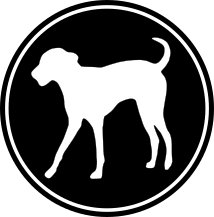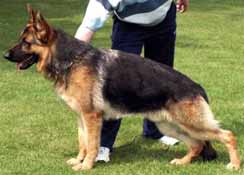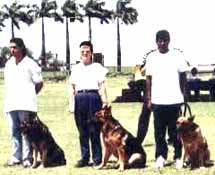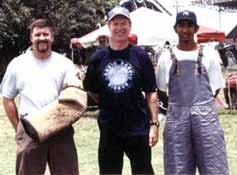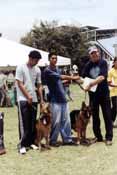Revised December 2011.
It was an honor and a pleasure to be invited to again judge in the Caribbean country of Trinidad & Tobago, this time by the German Shepherd Breed Club of T&T, the previous assignment having been sponsored by the Rottweiler Club. But in both cases, these two breeds, being the most populous, work closely together. Ten years ago I awarded a GSD Best in Show, but this year, while the average Shepherd quality was definitely higher, there was not that outstanding example that I seem to remember from 1994. Trinidad & Tobago (the name of the country and referring to the big island and the smaller, respectively) is the last in the chain of West Indies islands curving from Cuba and Puerto Rico to South America. Just off the Venezuela coast (you could see the mainland from the northwestern peninsula of T&T), this is a country that got its independence from England in the 1960s, but retains the old-world antiquated ideas on quarantines. Thus, importation of “new blood” is difficult and results in high expense, and sometimes poor development of health and temperament while in the isolation of quarantine. Only adults or the genetically strong pups come out of that long period normal. There is no quarantine from UK and some Caribbean countries, so most imports come from Britain, but 6 months quarantine from the other countries. Despite such a hardship, recent German lines such as Timo, Bax, and Ursus can be had by importing these from England instead of from the breed’s fatherland.
Trinidad’s ethnic make-up is mixed. The largest population descends from African slaves, the second most numerous are descendants from East Indian indentured servants (a small step up from outright slaves), and the third place is shared by English or other Caucasians and descendants of Chinese merchants. It makes for a colorful and copasetic combination.
This year, instead of judging only conformation, I was also asked to deliver two lectures and to put my training experience to work, thus necessitating almost a week’s stay in the tropics. As a result, I had a chance to be or greater service to the dog fancy as well as tour wildlife preserves and to sample the cuisine more comprehensively. The tropical fruits are often exotic and always delicious! After returning to Alabama, I got a kick out of telling people about my eating giant rats there. The mother of one of the club members arranged a wild-game dinner consisting of the green callaloo top (made into a thick spinach-like soup) and the sugar-beet-like root portion of a native plant; cassava root; local shrimp; curried goat; and other things from the forests and bayous. The centerpiece of the dinner was a big bowl of lappe and agouti, two similar varieties of local large rodents. Basically huge rats (bigger than the largest housecat you’ve ever seen), live specimens of these brindle-gray animals were in the zoo that I visited a couple days earlier, and my guide was amused by my pointing them out and saying, “Look! Dinner!”
This year’s event was organized for the T&T Kennel Club by their largest member club, the German Shepherd Breed Club of Trinidad and Tobago. It was sponsored by several dog food companies, each of which had a tent at ringside. The emphasis of the show was on developing the all-around companion dog, and for the “working” breeds, that meant adding protection and sociability testing. Here where crime rates are high, guard dogs are the most popular, although I saw a slightly higher percentage of non-working breeds than I had a decade earlier. Rottweilers, GSDs, Dobes, and “Pit-Bull” Terriers are among the most populous. The last-named is not registrable here, because it is not a “recognized” breed in jolly old England, whence T&T’s dog show and registry customs descend. It was a two-day event, with Obedience and Protection competitions on Saturday and the Conformation on Sunday. The format was considered very successful, as they sold some 300 catalogs to non-competing spectators, something that is a rarity in the States. Estimate the others who did not buy catalogs, and you get a good idea of the public interest. If they can get people away from air-conditioning and TV for such a turnout, I wonder why we can’t do half as well here in the U.S. Although there was some participation by members of the T&T Kennel Club, such as announcers, the entire weekend was run by the GSD Breed Club, recently accepted as a new member of WUSV.
The first event was the Protection trial, similar to Schutzhund-1. An APBT named Spike did not perform up to training standards in Protection, but had a respectable 86 points in Obedience. A number of dogs got their Canine Good Citizen certificates in the third segment of Saturday’s exhibition. The Obedience routine was similar to the Sub-Novice used by AKC and also had elements similar to UKC’s CD tests. A third APBT was a “spectator”, and was so good in type, he would have won many UKC shows.
The winner of the Protection test with a 94.5 points (the extra half-point to break the tie and help in calculating total points by year-end) was a Malinois that was not entered in any other competition. Second in Protection was a well-structured GSD Sieger Ursus daughter, Esther HausWalderbach, who was pulled from conformation because she was badly out of coat, largely due to the bad situation I found in several entries, from fleas and flies and partly from having whelped 6 weeks earlier. She was owned by Christopher Seeyave, the young man (a student) who also got 3rd in Protection with his other GSD, Karlo Lachenerweg. Karlo, bred by Jochen Janz who occasionally handles in USA shows, is a son of 2003 Sieger Bax, and won the two-day “Total Dog” competition (over-all best in combined scores) with 90 points in Protection, 90.5 points in Obedience, and 2nd place in Limit Dog class in Conformation.
One of the helpers, giving most of the bites, was Mark Chin Aleong, who owned several of the top GSDs and Dobes. The other helper, Kevin Kent, was recently from the east coast of the U.S., and after having been stationed in T&T during his stint as a Marine, he fell in love with the island and put down roots.
The Obedience routine was similar to the Sub-Novice used by AKC and also had elements similar to UKC’s CD tests and the SV’s BegleitHund. An additional job they gave me for Saturday was to judge a “Canine Good Citizen” test, which was even more like the BH’s second section. All but one dog passed that, the exception being a Weimaraner that bit the cyclist’s leg, though it only damaged his trouser! First in Obedience, 4th in Open Dog conformation, and earning the CGC certificate was a German Shepherd Dog import from Barbados named Netanya’s Karly and owned by Sabra Bahadoorsingh. She also got a CGC and a 2nd in Obedience with another of her GSDs, but had not trained either of them for protection work.
Although Protection was dominated by GSDs, a good-looking “APBT” (purebred American Pit Bull Terrier, though not registered anywhere) named “Red” did a wonderful protection routine except for the “Out” where he lost a lot of points for not releasing promptly with few commands. I gave him 4th place with 87 points and a “Good” rating, and he later finished in a tie for 5th in Obedience with 90.5 points. He also got the Canine Good Citizen certificate in the third segment of Saturday’s exhibition.
Conformation competition was also dominated numerically by the German Shepherds and the Rottweilers, but the quality of the latter was very poor with only one exceptional specimen. Dobes were both plentiful and generally quite good in conformation. It was also a pleasure to see a half-sister of my own SchH-3 GSD bitch (a Timo daughter now nursing pups in my kennel in Holland) and to give her a Reserve Challenge Certificate… something like a Reserve Winners Bitch. The CC went to a great-granddaughter of Hoss Hasenborn from the Junior Bitch class because of better ribbing and size, though the yellow eyes were slightly disconcerting.
Males in the GSD competition were better over-all. There were several with great promise. BOB from the Open class went to a VA3 Esko DanischenHof son bred by Sue Hadley and imported from England by Mark Chin-Aleong: Bygoly El Devino From Videx. He faded during the Group competition. Second in Open Dogs was Korzwin Henry, linebred 4,6-4,5 on the 1984-85 Sieger Uran WildsteigerLand; he sired several of the placing puppies, so the Uran “blood” will continue here for some time. Third was a very nice Cim Ecknachtal grandson, and when I read that name in the e-mails later, I was struck with sorrow because I had just lost my terrific 10-year-old Cim son “Iron” to torsion.
In the Limit Dog Class (have not yet won 3 Challenge Certificates), the winner was an Esko grandson (son of Henry Dunischenke & Nancy Oxalis): Videx Yassko, bred by David and Rhoda Payne and imported/owned by the same man who owns the BOB. Behind him was Karlo, the Bax son mentioned earlier. For those of you familiar with Easter-bloc lines and Czech dogs, the solid black male earning 3rd Limit Dog was the Czech import, Ciro Kvero, sired by Nucky Naspo (Gent od Policie son) x Chola Policia (a Titus Pohracini Straze daughter); Titus is by Bero Friedorferflur. If he hadn’t been so out at the elbows, he would have looked even better than he did — a very handsome and masculine dog! His black daughter’s elbows were a little tighter, and she got 2nd in the Junior Bitch class, behind the eventual Bitch Winner.
In the Group and BIS competition, there were several world-class dogs. Notable exhibitions were the Reserve BIS Dobe and the 8-year-old Golden Retriever, both bred in the USA; and the BIS Basset Hound and the winning Lhasa Apso, both imports from the UK. Another top-quality dog was an imported Rhodesian Ridgeback, but because of the unfortunate rule here against showing a bitch in season (she just started that morning), this beauty was excluded from competition after the prerequisite vet exam. The quality level of these dogs was formidable, so the German Shepherd Dog was in good company.
|
|
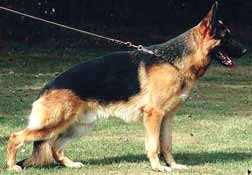
|
|
|
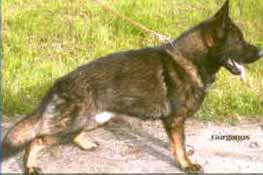
|
|
|
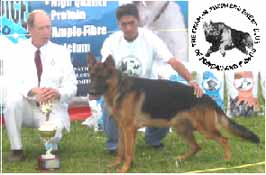
|
|
|
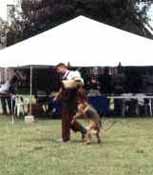
|
